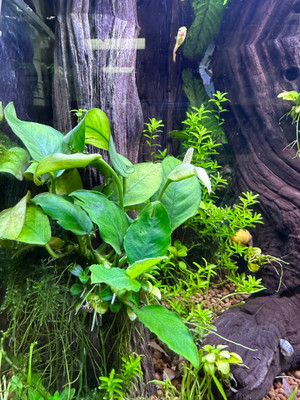Anubias: A Versatile and Resilient Freshwater Plant
Posted by Max Gandara on on 2nd Jun 2023
Anubias: A Versatile and Resilient Freshwater Plant
Introduction:
Anubias is a popular freshwater plant renowned for its aesthetic appeal
and ease of care. This versatile aquatic plant belongs to the Araceae
family and is native to the tropical regions of Africa. With its
attractive dark green leaves and ability to thrive in various aquatic
environments, Anubias has become a favorite among aquarists and aquatic
plant enthusiasts worldwide. This article will delve into the
fascinating characteristics, care requirements, and benefits of
incorporating Anubias in your freshwater aquarium.
Appearance and Varieties:
Anubias plants possess broad, leathery leaves that are typically
heart-shaped or elongated, depending on the species. They are
characterized by dark green hues and a glossy sheen, which adds elegance
and depth to any aquarium. The plant's unique structure includes a
thick rhizome from which the leaves and roots emerge. Anubias species
vary in size, with smaller varieties such as Anubias nana and Anubias
petite reaching around 5-10 centimeters in height, while larger species
like Anubias barteri can grow up to 30 centimeters tall.
Popular Anubias species include:
1. Anubias nana
2. Anubias barteri
3. Anubias coffeefolia
4. Anubias congensis
5. Anubias heterophylla
Adaptability and Low Maintenance:
One of the key advantages of Anubias is its adaptability to a wide range
of water conditions. It can thrive in both low-light and moderate-light
environments, making it an ideal choice for aquariums with varying
levels of lighting. Additionally, Anubias can tolerate a range of water
parameters, including pH levels between 6.0 and 7.5, and temperatures
between 22-28 degrees Celsius (72-82 degrees Fahrenheit). Its ability to
withstand suboptimal conditions makes it a suitable option for
beginners or aquarists who prefer low-maintenance setups.
Placement and Propagation:
Anubias can be placed in the foreground or background of an aquarium,
depending on its size and growth habit. The plant's rhizome should not
be buried in the substrate but rather attached to driftwood, rocks, or
other decorations using fishing line or plant-safe adhesive. This
placement allows the roots to absorb nutrients from the water column.
Anubias propagates through the growth of new leaves from the rhizome, or
through division, where the rhizome is separated into smaller sections
with roots and leaves.
Benefits to the Aquarium Ecosystem:
In addition to its aesthetic appeal, Anubias offers several benefits to
the aquarium ecosystem. The plant contributes to water quality by
absorbing nitrates, ammonia, and other pollutants, thus aiding in the
maintenance of a healthy environment for fish and other aquatic
inhabitants. Anubias also provides natural shelter and hiding places for
fish, particularly for shy species or those seeking refuge from
aggressive tankmates. The dense foliage of Anubias leaves creates a
calming and natural ambiance, enhancing the overall aesthetic of the
aquarium.
Conclusion:
Anubias is an exceptional freshwater plant that adds beauty and
functionality to aquariums of all sizes. Its striking appearance,
adaptability, and low maintenance requirements make it an excellent
choice for both novice and experienced aquarists. Whether used as a
focal point or as a background plant, Anubias provides numerous benefits
to the aquarium ecosystem, including water purification and enhanced
fish well-being. Consider adding Anubias to your freshwater aquarium and
enjoy the beauty and tranquility it brings to your aquatic haven.

